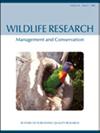Effects of helicopter net gunning on the survival and movement behaviour of nilgai antelope
IF 1.6
3区 生物学
Q3 ECOLOGY
引用次数: 0
Abstract
ABSTRACT Context. Research on large, terrestrial mammals often requires physical captures to attach tags or collars, collect morphological data, and collect biological samples. Choice of capture method should minimise pain and distress to the animal, minimise risk to personnel, and consider whether the method can achieve study objectives without biasing results. Aims. We studied how capture via helicopter net-gunning affected survival, post-capture movement patterns, and space use of exotic nilgai (Boselaphus tragocamelus) in southern Texas, USA. Methods. We estimated daily survival rates for 101 collared nilgai over 28 days, following 125 captures. We calculated mean daily movement rates and net-squared displacement for 21 recaptured nilgai for 60 days, starting 30 days before capture. Key results. The survival probability of 125 nilgai individuals was 0.97 (95% CI = 0.92–0.99) over the 28 days following capture, with the lowest daily survival for the day after capture (x̄ = 0.99; 95% CI = 0.96–1.00). We observed an increase of ~65% in the mean daily movement rate of 134 m/h on the first 2 days since capture, followed by a period of reduced movement out to the 5th day before returning to pre-capture levels. Analysis of net-squared displacement for 21 nilgai showed that 17 resumed pre-capture space-use patterns within a week, whereas four individuals did not return to the pre-capture range for ≥1 month. Conclusions. Capture-related mortality rates for nilgai using helicopter net-gunning in our study (3%) were similar or lower than those reported for similar species captured using the same method. While we were able to detect a period of elevated movement rates, followed by a recovery period of diminished movement as a result of capture, nilgai appeared to return to typical behaviour ~6 days post-capture. Most nilgai in our study also resumed typical space-use patterns within a week of capture; however, our results suggest high individual variability in their response. Implications. We recommend using net-gunning from a helicopter as a method for capturing nilgai when conditions and where vegetation and topography allow. We suggest censoring data for a minimum of 7 days following capture for analyses related to survival and movement rates. For analyses relating to space use, we suggest inspecting net-squared displacement or some similar displacement analysis for each animal separately to account for individual variation in response and exclude data accordingly.直升机网射对nilga羚羊生存和运动行为的影响
本文章由计算机程序翻译,如有差异,请以英文原文为准。
求助全文
约1分钟内获得全文
求助全文
来源期刊

Wildlife Research
生物-动物学
CiteScore
4.30
自引率
15.80%
发文量
56
审稿时长
3 months
期刊介绍:
Wildlife Research represents an international forum for the publication of research and debate on the ecology, management and conservation of wild animals in natural and modified habitats. The journal combines basic research in wildlife ecology with advances in science-based management practice. Subject areas include: applied ecology; conservation biology; ecosystem management; management of over-abundant, pest and invasive species; global change and wildlife management; diseases and their impacts on wildlife populations; human dimensions of management and conservation; assessing management outcomes; and the implications of wildlife research for policy development. Readers can expect a range of papers covering well-structured field studies, manipulative experiments, and analytical and modelling studies. All articles aim to improve the practice of wildlife management and contribute conceptual advances to our knowledge and understanding of wildlife ecology.
Wildlife Research is a vital resource for wildlife scientists, students and managers, applied ecologists, conservation biologists, environmental consultants and NGOs and government policy advisors.
Wildlife Research is published with the endorsement of the Commonwealth Scientific and Industrial Research Organisation (CSIRO) and the Australian Academy of Science.
 求助内容:
求助内容: 应助结果提醒方式:
应助结果提醒方式:


